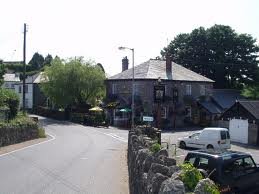


A hidden gem of a village
The village of Luxulyan lies four miles north-east of St. Austell, six miles south of Bodmin and three miles south-west of Lostwithiel. It is best known for the Luxulyan Valley, a steep sided and thickly wooded stretch of the valley of the River Par that contains a major concentration of early 19th century industrial remains, including a combined aqueduct and viaduct built by Joseph Treffry in 1842. The valley was designated a World Heritage Site in 2006. The population of the village was 1,490 at the 2011 census.
The whole area is surrounded by granite quarries from which granite was taken to build Plymouth breakwater and London Bridge. Luxulyanite, a rare type of Cornish granite (named after the village) is found in the area and was used for the Duke of Wellington's sarcophagus in St. Paul's Cathedral.
St. Sulien, or Sulian, was abbot here during the 6th century. The church in the village may have been dedicated to him originally, but it is now dedicated to St. Cyriacus, and Julitta. The parish church, originally Norman, was entirely rebuilt in granite in the 15th century. St. Cyor's Holy Well, is located under a stone canopy at the lower end of the village, is now dried up. The Blackmoor Stannary, centred at nearby Hensbarrow Beacon, kept its records stored in the church. Parson John Cole who was vicar of Luxulyan from 1728 - 1773 is reported to still inhabit the Vicarage as a ghost, and his son still haunts the Parish of Warleggan.
The Holy Well at Luxulyan, dedicated to St. Cyors, is located on the right just as you enter the village from the south-east. It is housed within a 15th Century well house, restored by the Old Cornwall Society in 1945.
The remains of an Iron-Age hillfort known as Prideaux Castle are located in the southern portion of the parish near the border with St. Blazey.
The Atlantic Coast Line from Par to Newquay runs up the Luxulyan Valley and there is a railway station at Luxulyan. A bus service connects the village with St. Austell and Lostwithiel.
In 1864 a dispute arose over silver and gold coins, from the reigns of Queen Elizabeth, King James and King Charles I, which were found in the parish churchyard. The Duchy of Cornwall had asserted its right to them as treasure trove, but the Solicitor to the Treasury questioned this, asking for copy documents under which "the claim of the Duchy was founded." The Duchy sent copies of the Charters of its creation and correspondence stating that, as the Coroner is the officer responsible for treasure trove, and the Duke has the right of appointing the Coroner within Cornwall, the treasure trove belonged to the Duchy. It also argued that the third Duchy Charter "expressly prohibits any such Minister of the Crown acting within Cornwall." In response the Government Attorney and Solicitor General advised that the Treasury back down as could not hold an Inquest of Treasure within the The Duchy of Cornwall and that they could not execute any writs because of the exclusion of all Ministers of the Crown from entering any lands of the Duchy.
In the early 1980's Luxulyan was the site of a six-month occupation of farmland by much of the village population, with many groups and individuals from across Cornwall helping, to prevent test drilling by the Central Electricity Generating Board investigating the area as a potential nuclear power station site.
Silvanus Trevail (1851–1903) who became one of Cornwall's most famous architects was born near Luxulyan.
William O'Bryan (1778- 1868) Methodist preacher and founder of the Bryanites or Bible Christians was born in the village.
Picrous Day is believed to have been especially popular in Luxulyan where celebrations were held at the Rising Sun Inn on the first Thursday before Christmas.
The southern part of the route of The Saint's Way passes through the village.
Luxulyan Valley St. Austell St. Blazey Lostwithiel Luxulyan Museum & Heritage Centre